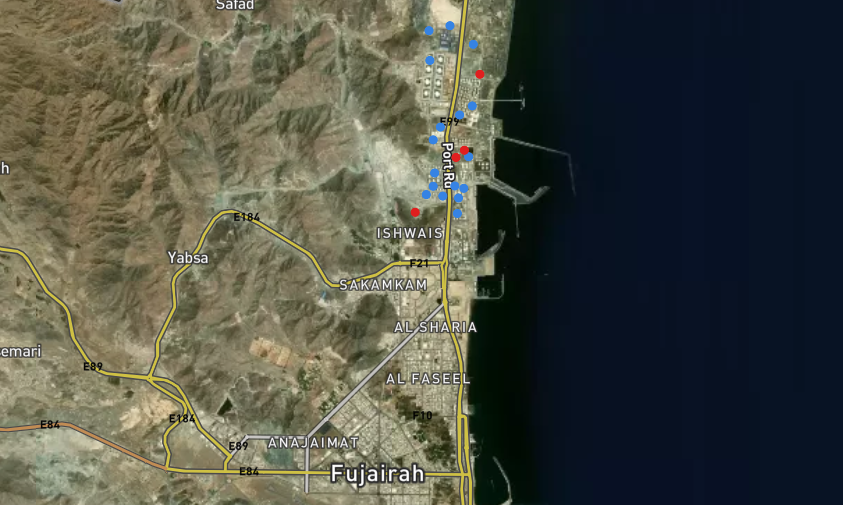
UAE Expands Strategic Oil Hub To Counter Iranian Threat
The geopolitically critical positioning of the UAE’s Fujairah as an alternative global crude oil storage facility and transit hub to the perennially troublesome Strait of Hormuz route continued last week, with the announcement that deliveries have now begun on the Fujairah Terminal expansion by Abu Dhabi (AD) Ports Group.
According to comments by the company’s commercial director-ports, Julian Skyrme, the AED1 billion (US$272 million) investment in the expansion has added container capacity of 720,000 twenty-foot equivalent units and general cargo capacity of 1.3 million metric tonnes.
This push from Fujairah comes after the finalisation in July 2021 of Iran’s own game-changing crude oil storage, transport and delivery mechanism, the Jask Oil Terminal and the 42-inch Guriyeh-Jask pipeline.
As analysed in depth in my new book on the global oil markets, the significance of this new Iranian crude oil export terminal can barely be overstated, as it allows Iran to transport huge quantities of oil and petrochemicals from its major oil fields via Guriyeh in the Shoaybiyeh-ye Gharbi Rural District of Khuzestan Province, 1,100 kilometres to Jask port in Hormozgan province, which is perfectly strategically placed on the Gulf of Oman.
At the same time, the Guriyeh-Jask pipeline allows Tehran the option of disrupting all other oil supplies that travel through the Strait of Hormuz – around 35 percent of the world’s total.
“Even before U.S. sanctions were re-introduced [in 2018], the Kharg terminal accounted for around 90 percent of all of Iranian oil export loadings, with the remaining loads going through terminals on Lavan and Sirri, which made obvious and easy targets for the U.S. and its proxies to cripple Iran’s oil sector and therefore its economy,” a senior oil and gas industry source who works closely with Iran’s Petroleum Ministry exclusively told OilPrice.com.
“In addition, the extreme narrowness of the Strait of Hormuz means that oil tankers have to travel very slowly through it, so pushing up the transit costs and delaying revenue streams,” he said.
“Conversely, Iran wants to be able to use the threat – or reality – of closing the Strait of Hormuz for political reasons without also completing destroying its own oil exports revenue stream,” he added.
It was precisely such an incident – the 2011/12 Strait of Hormuz Dispute – that the once fanciful notion of Fujairah (one of the UAE’s smallest and lesser known emirates) becoming one of the world’s great oil storage and trading hubs alongside the Far East’s Singapore hub, Europe’s ARA (Amsterdam-Rotterdam-Antwerp), and the U.S.’s Cushing gained real momentum.
This Dispute began in December 2011 when Iran threatened to cut off oil supply through the Strait should economic sanctions limit, or halt, Iranian oil exports, and it included a 10-day military exercise in international waters near the chokepoint.
Fujairah at that point was recognised as having an extremely strategically advantageous position to deal with such potential supply disruptions, being located both outside the Persian Gulf and a healthy 160 kilometres away from the Strait of Hormuz.
It was also seen as not aligned to any possibly pro-Iranian country, such as Oman, which at that time was considering plans with Iran to co-operate in Tehran’s build-out of a world-class liquefied natural gas (LNG) sector.
An additional advantage that Fujairah offered in that 2011/2012 analysis was that it affords international oil companies the facility to do business in the same generally transparent and non-corrupt legal framework found across the UAE.
Various stages of Fujairah’s expansion plans were subject to delays prior to the onset of the major downturn in global oil prices in 2020, due to lower forward oil prices making hydrocarbons storage a less attractive option.
However, each element of the project to make Fujairah the pre-eminent Middle Eastern storage hub – termed ‘Black Pearl’ – gradually came into line. The pace of this picked up after the 380 kilometre Abu Dhabi Crude Oil Pipeline from the Habshan onshore field in Abu Dhabi to Fujairah city became operational in June 2012, capable of transporting 1.8 million bpd and allowing for the smooth movement of UAE crude to the global market.
At that time, Fujairah also expedited the rolling out of a wide range of the corollary services required in a global storage hub. These included facilities for the loading and discharge of partially laden very large crude carriers (VLCCs) for crude oil and refined products, the blending of crude oil, fuel oil and clean products, the storage and supply of bunker fuel, and inter- and intra-tank cargo transfer.
Within a relatively short time, the Fujairah port’s jetties had the capacity to accommodate both small barge vessels – 3000 deadweight tonnage (DWT) – and the larger VLCCs (up to 300,000 DWT).
In 2015, Vopak Horizon Fujairah also announced that it was building five crude oil storage tanks with total capacity of 478,000 cubic metres at the port and intended to expand that number.
Part of the positive backdrop for the continued expansion of the Fujairah hub was always expected to be the trade flows coming out of the Dubai Multi-Commodities Centre, with more storage capacity allowing traders greater flexibility in their deals, and a very supportive financial infrastructure created by the Fujairah authorities.
This proved to be the case and Fujairah further stands to benefit from the ongoing rise in volumes traded over the recently established Abu Dhabi-based ICE Futures Abu Dhabi (IFAD), with its focus on the trading of futures contracts for the light, sweet Murban crude oil that constituted around half of the UAE’s total near-4 million bpd crude oil production before the outbreak of the COVID-19 pandemic in 2020.
OilPrice by Simon Watkins, February 9, 2022
